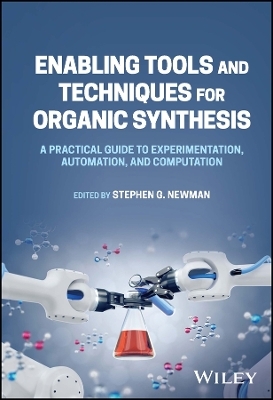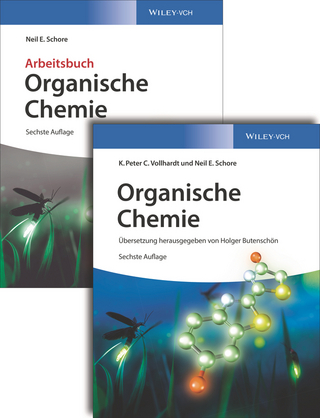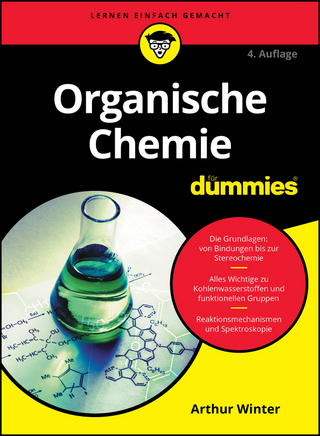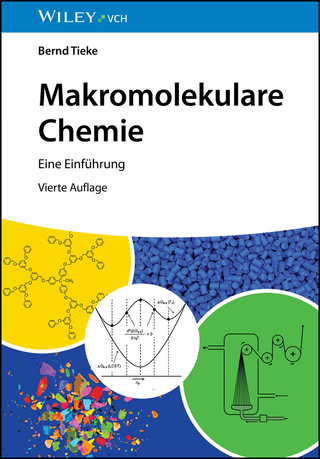
Enabling Tools and Techniques for Organic Synthesis
John Wiley & Sons Inc (Verlag)
978-1-119-85563-7 (ISBN)
In recent years, new technologies have impacted organic chemistry to the point that they are no longer the sole domain of dedicated specialists. Computational chemistry, for example, can now be used by organic chemists to help predict outcomes, understand selectivity, and decipher mechanisms. To be prepared to solve various synthetic problems, it is increasingly important for chemists to familiarize themselves with a range of current and emerging tools and techniques.
Enabling Tools and Techniques for Organic Synthesis: A Practical Guide to Experimentation, Automation, and Computation provides a broad overview of contemporary research and new technologies applied to organic synthesis. Detailed chapters, written by a team of experts from academia and industry, describe different state-of-the-art techniques such as computer-assisted retrosynthesis, spectroscopy prediction with computational chemistry, high throughput experimentation for reaction screening, and optimization using Design of Experiments (DoE). Emphasizing real-world practicality, the book includes chapters on programming for synthetic chemists, machine learning (ML) in chemical synthesis, concepts and applications of computational chemistry, and more.
Highlights the most recent methods in organic synthesis and describes how to employ these techniques in a reader’s own research
Familiarizes readers with the application of computational chemistry and automation technology in organic synthesis
Introduces synthetic chemists to electrochemistry, photochemistry, and flow chemistry
Helps readers comprehend the literature, assess the strengths and limitations of each technique, and apply those tools to solve synthetic challenges
Provides case studies and guided examples with graphical illustrations in each chapter
Enabling Tools and Techniques for Organic Synthesis: A Practical Guide to Experimentation, Automation, and Computation is an invaluable reference for scientists needing an up-to-date introduction to new tools, graduate students wanting to expand their organic chemistry skills, and instructors teaching courses in advanced techniques for organic synthesis.
Stephen G. Newman, PhD, is an Associate Professor and Tier 2 Canada Research Chair at the Centre for Catalysis Research and Innovation, University of Ottawa, Canada. His current work focuses on transition metal catalysis and flow chemistry strategies to develop new chemical reactions and processes for application in the pharmaceutical, fine, and bulk chemical industries.
List of Contributors xv
Preface xix
1 Biocatalysis 101 – A Chemist’s Guide to Starting Biocatalysis 1
Pablo Díaz- Kruik, David Lim, and Francesca Paradisi
Glossary 1
1.1 Introduction 1
1.1.1 Enzymes – the Green and Sustainable Way of the Future 1
1.1.2 Enzymatic and Organic Catalysis Are Not too Different from Each Other 3
1.1.3 Enzymes 101 4
1.2 When Should I Choose an Enzyme over a Chemical Catalyst? 4
1.3 Key Considerations for Running Biocatalytic Reactions 6
1.3.1 Dispelling Myths 6
1.3.1.1 Enzymes Are Not Safe to Use 7
1.3.1.2 Enzymes Are Not as Readily Available as Chemical Catalysts 7
1.3.1.3 Enzymes Are Seldom Useful Due to Their Limited Substrate Scope 7
1.3.1.4 The Cost of Enzyme Production Is Very High 8
1.3.1.5 Enzymes Are Functionally Unstable Under Organic Conditions 9
1.3.1.6 Sustainability 9
1.3.2 Challenges of Using Enzymes: the Need for Strict Reaction Conditions 9
1.3.2.1 Enzymes from Extremophiles 10
1.3.2.2 Solvents (and Co- solvents) 10
1.3.2.3 Concentration and Ionic Strength of the Buffer 10
1.3.2.4 pH Dependence 11
1.3.2.5 Concentration of Reactants 11
1.3.2.6 Enzyme Concentration 12
1.3.2.7 Enzyme Forms 12
1.3.2.8 Toxicity 13
1.3.3 What Do I Need to Start Biocatalytic Experiments in My Lab? 13
1.3.4 Additional Considerations 14
1.4 Transformations Catalyzed by Enzymes 15
1.4.1 EC – The Enzyme Commission Number 15
1.4.1.1 EC 1 – Oxoreductases 15
1.4.1.2 EC 2 – Transferases 16
1.4.1.3 EC 3 – Hydrolases 16
1.4.1.4 EC 4 – Lyases 17
1.4.1.5 EC 5 – Isomerases 18
1.4.1.6 EC 6 – Ligases 18
1.4.1.7 EC 7 – Translocases 18
1.4.2 Some Applications of Selected Commercially Available Enzymes 19
1.4.2.1 Horseradish Peroxidase 19
1.4.2.2 Lysozyme 19
1.4.2.3 Trypsin 20
1.4.2.4 Candida Lipase B 20
1.4.2.5 Amino Acid Dehydrogenase 20
1.4.2.6 Glycosidases 21
1.4.3 Engineered (Unnatural) Reactions 21
1.5 New Trends and Technologies in Biocatalysis 21
1.5.1 Flow Biocatalysis and New Technologies 21
1.5.1.1 What Is Flow Biocatalysis? 21
1.5.1.2 How Does Flow Biocatalysis Work? 21
1.5.1.3 When Is a Flow Process More Beneficial for a Specific Transformation? 23
1.5.1.4 Should One Implement Every Enzymatic Reaction in Flow? 23
1.5.2 Enzyme Engineering 24
1.5.3 Photobiocatalysis 25
1.6 Flow Chart to Biocatalysis 25
1.7 Case Study: Setting up a Biotransformation 27
1.8 Concluding Remarks 31
Additional Resources 31
References 31
2 Introduction to Photochemistry for the Synthetic Chemist 37
Stefano Protti, Davide Ravelli, and Maurizio Fagnoni
Glossary 37
2.1 Introduction 38
2.1.1 Light to Make Your Synthesis Greener 38
2.1.2 A Way to Overcome HOMO/LUMO Interactions 39
2.2 How to Plan a Photochemical Synthesis 45
2.2.1 The Choice of the Solvent 45
2.2.2 Concentration of the Absorbing Species 47
2.2.3 The Reaction Vessel 48
2.2.4 Light Sources 48
2.2.4.1 Low- Pressure Mercury Arcs 49
2.2.4.2 Medium- and High- Pressure Mercury Arcs 50
2.2.4.3 Other Light Sources 50
2.2.5 From Batch to Flow Conditions 52
2.2.6 Preparation of the Sample 54
2.2.7 Safety Equipment 54
2.3 Selected Applications of Photochemical/Photocatalyzed Reactions 55
2.3.1 Reactions Involving the C═C Double Bond 55
2.3.2 Reactions Involving the C═O Double Bond 58
2.3.3 Reactions Involving a Photoinduced Homolysis 60
2.3.4 Reactions Involving Singlet Oxygen 62
2.3.5 Reactions Involving a Photocatalytic Step 62
2.4 Conclusions 67
Acknowledgment 67
References 67
3 How to Confidently Become an Electrosynthetic Practitioner 73
Sylvain Charvet, Taline Kerackian, Camille Z. Rubel, and Julien C. Vantourout
Glossary 73
Abbreviations 76
3.1 Introduction 77
3.2 General Definition of Organic Electrosynthesis 78
3.3 Why is Organic Electrosynthesis Used? 78
3.4 How is Organic Electrosynthesis Performed? 78
3.5 Where to Start with Electrosynthesis? 79
Selected General Reviews 79
Selected General Guides 79
3.6 Electrasyn 2.0 80
3.6.1 Machine and Consumables 80
3.6.1.1 Opening the IKA ElectraSyn 2.0 Box 80
3.6.1.2 Cell (Vial and Cap) 81
3.6.1.3 Electrodes 82
3.6.2 Interface 83
3.6.2.1 Hardware 83
3.6.2.2 Menus 84
3.6.3 How to Set Up the Cell 84
3.6.4 How to Start an Experiment 85
3.6.5 During the Reaction 88
3.6.6 After the Reaction 89
3.7 Case Study 90
3.7.1 Project Overview 90
3.7.2 Optimization of Parameters 92
3.7.2.1 Designing an Electrochemical Experiment 92
3.7.3 Proof of Concept 94
3.7.3.1 Optimization 94
3.7.3.2 Substrate Scope 102
3.8 Conclusion 103
References 103
4 Flow Chemistry 107
Yosuke Ashikari and Aiichiro Nagaki
Glossary 107
4.1 Introduction 109
4.1.1 What is Flow Microchemistry 109
4.1.1.1 Reaction Time Controllability 110
4.1.1.2 Fast Mixing 111
4.1.1.3 Temperature Controllability 112
4.1.2 Reactions Enabled by Flow Microreactors 112
4.1.2.1 Competitive Sequential Reactions 112
4.1.2.2 Reactions Mediated by Unstable Intermediates 114
4.1.2.3 Reactions Occurring at the Surface: Two- Phase Reactions, Electrochemical Reactions, and Photoreactions 117
4.1.3 Further Applicability of Flow Microsynthesis 118
4.1.3.1 Scalability 118
4.1.3.2 Safety Operation 118
4.2 General Information for Flow Microreactors 118
4.2.1 Tools and Equipment for Flow Chemistry 119
4.2.1.1 Micromixer 119
4.2.1.2 Tube Reactor 120
4.2.1.3 Pump 120
4.2.1.4 Pre- Cooling Tubes 121
4.2.1.5 PTFE Tubes 121
4.2.2 How to Perform Experiments 122
4.2.2.1 Selection of Reaction Conditions 122
4.2.2.2 Preparation of Reagent Solution 125
4.2.2.3 Preparation for Reactions 126
4.2.2.4 Preparation for Reaction Evaluation 128
4.2.2.5 Cleaning Up 129
4.3 Case Studies 129
4.3.1 Competitive Sequential Reaction (General Procedure) 129
4.3.1.1 Preparation 130
4.3.1.2 Experiment 132
4.3.1.3 Screening of Reaction Conditions 133
4.3.1.4 Analysis 134
4.3.1.5 Clean Up 136
4.3.2 Reactions Mediated by Short- Lived Intermediates 136
4.3.3 Reaction Integration 139
4.4 Further Expertise 142
4.4.1 Reaction Integration 142
4.4.2 Chemoselective Reactions 143
4.4.3 Heterogeneous Catalytic Reactions 143
4.5 Summary and Outlook 144
References 144
5 Reaction Optimization Using Design of Experiments 149
Laura Forfar and Paul Murray
Glossary 149
5.1 Introduction 151
5.1.1 How Do We Experiment and DoE Terminology 151
5.1.2 OVAT vs. DoE 153
5.1.2.1 A Simple Chemical Example 153
5.1.3 A Note on Error, Accuracy, and Precision 156
5.2 When and How Can DoE Be Used? 157
5.3 What Information Can I Get from a DoE and How Is It Obtained? 158
5.3.1 Which Factors Are Important? 159
5.3.2 How Are the Models Generated? 161
5.4 What Types of Design Are Available? 164
5.4.1 Screening Designs 164
5.4.1.1 Fractional Factorial Designs 165
5.4.1.2 Definitive Screening Designs 166
5.4.2 Designs for Optimizing Reactions 167
5.4.3 Response Surface Designs 167
5.5 The DoE Process 169
5.5.1 Aim and Objective 170
5.5.2 Selecting Factors and Ranges 171
5.5.2.1 Factors 171
5.5.2.2 Ranges 173
5.5.3 Selecting Responses 175
5.5.4 Select a Design to Answer the Objective 176
5.5.5 Carry Out Design and Analyze Samples 177
5.5.6 Check Results 178
5.5.7 Model Data 179
5.5.7.1 General Steps for Developing a Model 180
5.5.7.2 Wittig Reaction 181
5.5.7.3 Complementing the Design 187
5.5.8 Validate Predictions 189
5.6 Combining DoE with Other Screening and Optimization Techniques 191
5.7 Software 192
5.8 “I Tried Experimental Design But It Did Not Work” 193
5.9 Conclusion 194
References 195
6 Introduction to High- Throughput Experimentation (HTE) for the Synthetic Chemist 197
Stephanie Felten, Michael Shevlin, and Marion H. Emmert
Glossary 197
6.1 What Is HTE? 199
6.2 Why HTE and What Can It Achieve? 199
6.2.1 Commonly Perceived Barriers to Employing HTE in Synthetic Chemistry 200
6.2.1.1 Cost 200
6.2.1.2 Availability of Dedicated HTE Facilities 200
6.2.1.3 Access to Knowledge and Training 201
6.2.1.4 Perception of HTE as Antithesis of Hypothesis- driven Research 201
6.2.2 Advantages of HTE Workflows vs. Traditional Reaction Setup 203
6.2.2.1 Setup Time per Reaction 203
6.2.2.2 Miniaturization and Efficient Reagent Use 203
6.2.2.3 Multivariable vs. Sequential Optimization 203
6.2.2.4 Visualizing Reactivity Patterns 204
6.2.2.5 Serendipity in Reaction Discovery 204
6.2.2.6 Avoiding Cross- contamination 206
6.3 Practical Considerations and Tools for HTE 206
6.3.1 Outline of a Typical HTE Workflow 207
6.3.2 Types of HTE Designs 209
6.3.2.1 HTE for Reaction Discovery 209
6.3.2.2 HTE for Reaction Optimization 210
6.3.3 HTE Design Software: Tools for Building Arrays 211
6.3.4 HTE Reactors and Consumables 214
6.3.4.1 Reaction Blocks 214
6.3.4.2 HTE Vials 214
6.3.4.3 Reaction Blocks with Sealing Top Plate 215
6.3.4.4 Special Reactors for Photochemistry, Electrochemistry, and High- Pressure Reactions 215
6.3.4.5 Reaction Stirring and Temperature Control 217
6.3.4.6 Consumables 219
6.3.5 Considerations for Experimental Setup 220
6.3.5.1 Reaction Atmosphere 220
6.3.5.2 Reagent Preparation and Dispensing 221
6.3.5.3 Storage of Preplated Reagents 223
6.3.5.4 Pipetting 224
6.3.5.5 Solvent Evaporation 225
6.3.6 Analysis of HTE Screens 226
6.3.6.1 Suitable Instrumentation 226
6.3.6.2 Autosampler Configurations 226
6.3.6.3 Analytical Methods 227
6.3.6.4 Internal Standards and Assay Yields 227
6.3.6.5 Data Visualization and Analysis 228
6.3.7 The Role of Automation and Robotics in HTE 229
6.4 Section Summary and Outlook 232
6.5 Case Study 1: Development of an HTE Platform for Nickel- Catalyzed Suzuki–Miyaura Reactions 233
6.5.1 Motivation 233
6.5.2 Design of Test Reaction and Initial Ligand Screen 233
6.5.3 Second Round of Ligand/Base/Solvent Screens 235
6.5.4 Final Platform Design 237
6.5.5 Validation of Platform Design 237
6.6 Case Study 2: HTE Enabled Reaction Discovery and Optimization of Silyl- Triflate- Mediated C–H Aminoalkylation of Azoles 240
6.6.1 Motivation 240
6.6.2 Reaction Discovery Plate Design 240
6.6.3 Ligand Screen 243
6.6.4 Parallel Optimization of Three Reagents 244
6.6.5 Base Screen 244
6.7 Current Challenges and the Future of HTE 247
6.7.1 Summary and Conclusions 247
6.7.2 Remaining Challenges: The Next Frontiers 248
6.7.2.1 Biphasic Reaction Mixtures 248
6.7.2.2 Flow Chemistry and HTE 248
6.7.2.3 Reaction Profiling 249
6.7.2.4 Building Machine Learning Models to Predict Reactivity 249
6.7.2.5 Addressing Future Challenges 250
Acknowledgments 250
Further Recommended Reading 250
References 250
7 Concepts and Practical Aspects of Computational Chemistry 259
Martin Breugst
Glossary 259
7.1 Introduction 261
7.2 Hardware and Software Requirements for Computational Investigations 264
7.3 Typical Methods in Computational Organic Chemistry 265
7.3.1 General Aspects 265
7.3.2 Molecular Mechanics and Force Fields 266
7.3.3 Wave- Function Methods I – Hartree–Fock Theory 267
7.3.4 Wave- Function Methods II – Post- Hartree–Fock Theory 267
7.3.5 Semiempirical Methods 269
7.3.6 Density Functional Theory 269
7.3.7 Dispersion- Corrected Density Functional Theory 271
7.3.8 Typical Computational Times 272
7.4 Basis Sets Used in Computational Organic Chemistry 273
7.4.1 General Aspects of Basis Sets 273
7.4.2 Introduction to the Mathematical Formalism in Basis Sets 274
7.4.3 Polarization and Diffuse Functions 275
7.4.4 Basis Set Families 276
7.4.5 Effective Core Potentials (Pseudopotentials) 278
7.4.6 The Basis Set Superposition Error (BSSE) 279
7.5 Typical Computational Tasks in Organic Chemistry 279
7.5.1 Preliminary Remarks 279
7.5.2 Single- Point Calculations 281
7.5.3 Geometry Optimizations 281
7.5.4 Frequency Calculations 282
7.5.5 Intrinsic Reaction Coordinate (IRC) Calculations 284
7.5.6 Conformational Analysis 285
7.6 Notation of the Model Chemistry 286
7.7 The Diels–Alder Reaction as a Tutorial Case Study 286
7.7.1 General Aspects and Requirements 286
7.7.2 Preparing Input Files 288
7.7.3 Conformational Sampling – Generation of Initial Geometries 290
7.7.4 Geometry Optimizations of Starting Materials and Products 291
7.7.5 Locating the Transition States 294
7.7.6 Verifying the Nature of the Transition State 298
7.8 More Advanced Aspects 300
7.8.1 General Comments 300
7.8.2 Influence of Solvation 300
7.8.3 Integration Grid 302
7.8.4 Standard States 302
7.8.5 Treating Unpaired Electrons 303
7.9 Important and Frequently Used Keywords 304
7.10 Practical Considerations 304
7.11 Conclusions 306
References 306
8 NMR Prediction with Computational Chemistry 313
Amy T. Merrill, Wentao Guo, and Dean J. Tantillo
Glossary 313
8.1 Introduction 314
8.2 Quantum- Chemistry- Based Computational NMR 315
8.2.1 Methods 315
8.2.1.1 Time/Resources for Calculations 316
8.2.1.2 Structural Considerations in Modeling 317
8.2.1.3 Geometry Optimizations 323
8.2.1.4 Calculating Isotropic Shielding Constants 324
8.2.1.5 Common Pitfalls and How to Address Them 328
8.2.1.6 Converting to Chemical Shifts 329
8.2.1.7 Calculating Coupling Constants 330
8.2.2 Confidence Analysis 330
8.2.3 Computer- Aided Automated Approaches 332
8.2.3.1 Case 332
8.2.4 A Case Study 336
8.2.5 Practicing 1 H and 13 C Chemical Shift Prediction 338
8.3 Summary and Outlook 339
Key References 339
References 340
9 Introduction to Programming for the Organic Chemist 347
Jason M. Stevens
9.1 Introduction 347
9.2 Better Visualizations: Communicating Structure–Data Relationships 351
9.3 Text Extraction: Automating Density Functional Theory Calculations 354
9.4 Statistical Analysis: Deriving Insight from Historical Data 357
9.5 Machine Learning: A Predictive Model for Deoxyfluorination 359
9.6 Working with Public Datasets: Identifying Reactivity Cliffs 364
9.7 Running Simulations: Process Greenness 367
9.8 Application Development: Process Mass Intensity Predictor 371
9.9 Machine Learning for Reaction Optimization 374
9.10 Executing Robotic Tasks 378
9.11 Autonomous Reaction Optimization 381
9.12 Conclusion 384
References 385
10 Machine Learning for the Optimization of Chemical Reaction Conditions 393
A. Filipa de Almeida and Tiago Rodrigues
Glossary 393
10.1 Introduction 394
10.2 Prior Art and Alternative Methods for Rational Reaction Optimization 396
10.3 Reaction Optimization Using LabMate.ML 400
10.3.1 Step One: Accessing the LabMate.ML Code and Installation 401
10.3.2 Step Two: Initializing the Optimization Routine in LabMate.ML 402
10.3.3 Step Three: Iterative Optimization Routine 404
10.3.4 Examples 406
10.4 Primer on Evaluation Guidelines 408
10.4.1 Code and Dataset Availability 408
10.4.2 Retrospective Evaluation 409
10.4.3 Baselines and Comparing Tools 410
10.4.4 Prospective Evaluation 412
10.5 Outlook 414
References 416
11 Computer- Assisted Synthesis Planning 423
Zhengkai Tu, Itai Levin, and Connor W. Coley
Glossary 423
11.1 Introduction to Computer- Aided Synthesis Planning 424
11.1.1 Defining the Tasks and Use Cases 424
11.1.2 Historical Approaches to Computer- Aided Synthesis Planning 425
11.1.3 The Inflection Point of CASP Methods 425
11.1.4 Preliminaries on Molecular Representation and Cheminformatics 426
11.1.5 Outline of the Rest of the Chapter 428
11.2 Approaches and Algorithms for Retrosynthesis 428
11.2.1 Data- driven v. Expert- Driven Programs 428
11.2.2 Template- Based Approaches 429
11.2.3 Template- free Approaches with Graphs and Sequences 431
11.2.4 Multistep Planning Algorithms 433
11.3 Approaches and Algorithms for Condition Recommendation and Forward Synthesis 436
11.3.1 Condition Recommendation Approaches 436
11.3.2 Forward Synthesis Approaches 437
11.4 Select Examples of Software Tools for CASP 439
11.4.1 Open- Source Tools 439
11.4.1.1 Askcos 439
11.4.1.2 AiZynthFinder 440
11.4.1.3 Retro* 442
11.4.2 Closed- Source Tools 443
11.4.3 CASP Tools for Enzymatic Catalysis 446
11.4.4 Practical Considerations for CASP Programs 446
11.4.4.1 Traceability to Literature Precedent 447
11.4.4.2 How to Use CASP: Command Line Versus Graphical User Interface 447
11.4.4.3 Data Privacy 448
11.4.4.4 Customization Ability 448
11.5 Case Studies 448
11.5.1 Segler et al.’s Data- driven Program and A/B Testing Success 449
11.5.2 MIT’s ASKCOS Program and Robotic Synthesis Demonstration 449
11.5.3 Grzybowski’s Chematica/Synthia Program’s Experimental Validations and Acquisition 450
11.6 Conclusion 451
Key References 453
References 453
Index 461
| Erscheinungsdatum | 11.08.2023 |
|---|---|
| Verlagsort | New York |
| Sprache | englisch |
| Gewicht | 959 g |
| Themenwelt | Naturwissenschaften ► Chemie ► Organische Chemie |
| ISBN-10 | 1-119-85563-2 / 1119855632 |
| ISBN-13 | 978-1-119-85563-7 / 9781119855637 |
| Zustand | Neuware |
| Informationen gemäß Produktsicherheitsverordnung (GPSR) | |
| Haben Sie eine Frage zum Produkt? |
aus dem Bereich


